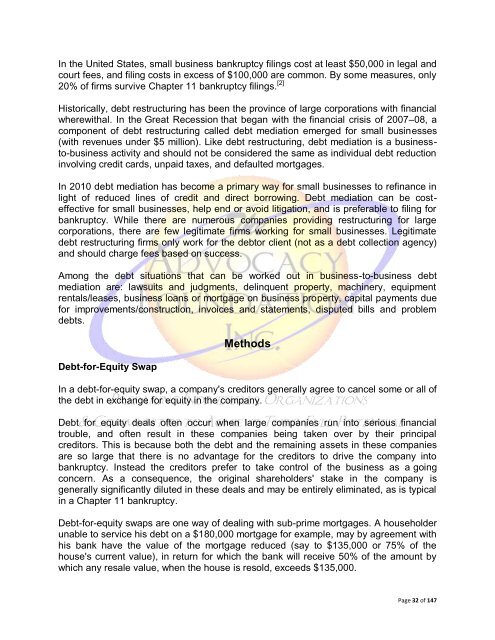Debt Reduction & Debt Relief
Debt Reduction & Debt Relief
Debt Reduction & Debt Relief
You also want an ePaper? Increase the reach of your titles
YUMPU automatically turns print PDFs into web optimized ePapers that Google loves.
In the United States, small business bankruptcy filings cost at least $50,000 in legal and<br />
court fees, and filing costs in excess of $100,000 are common. By some measures, only<br />
20% of firms survive Chapter 11 bankruptcy filings. [2]<br />
Historically, debt restructuring has been the province of large corporations with financial<br />
wherewithal. In the Great Recession that began with the financial crisis of 2007–08, a<br />
component of debt restructuring called debt mediation emerged for small businesses<br />
(with revenues under $5 million). Like debt restructuring, debt mediation is a businessto-business<br />
activity and should not be considered the same as individual debt reduction<br />
involving credit cards, unpaid taxes, and defaulted mortgages.<br />
In 2010 debt mediation has become a primary way for small businesses to refinance in<br />
light of reduced lines of credit and direct borrowing. <strong>Debt</strong> mediation can be costeffective<br />
for small businesses, help end or avoid litigation, and is preferable to filing for<br />
bankruptcy. While there are numerous companies providing restructuring for large<br />
corporations, there are few legitimate firms working for small businesses. Legitimate<br />
debt restructuring firms only work for the debtor client (not as a debt collection agency)<br />
and should charge fees based on success.<br />
Among the debt situations that can be worked out in business-to-business debt<br />
mediation are: lawsuits and judgments, delinquent property, machinery, equipment<br />
rentals/leases, business loans or mortgage on business property, capital payments due<br />
for improvements/construction, invoices and statements, disputed bills and problem<br />
debts.<br />
<strong>Debt</strong>-for-Equity Swap<br />
Methods<br />
In a debt-for-equity swap, a company's creditors generally agree to cancel some or all of<br />
the debt in exchange for equity in the company.<br />
<strong>Debt</strong> for equity deals often occur when large companies run into serious financial<br />
trouble, and often result in these companies being taken over by their principal<br />
creditors. This is because both the debt and the remaining assets in these companies<br />
are so large that there is no advantage for the creditors to drive the company into<br />
bankruptcy. Instead the creditors prefer to take control of the business as a going<br />
concern. As a consequence, the original shareholders' stake in the company is<br />
generally significantly diluted in these deals and may be entirely eliminated, as is typical<br />
in a Chapter 11 bankruptcy.<br />
<strong>Debt</strong>-for-equity swaps are one way of dealing with sub-prime mortgages. A householder<br />
unable to service his debt on a $180,000 mortgage for example, may by agreement with<br />
his bank have the value of the mortgage reduced (say to $135,000 or 75% of the<br />
house's current value), in return for which the bank will receive 50% of the amount by<br />
which any resale value, when the house is resold, exceeds $135,000.<br />
Page 32 of 147

















